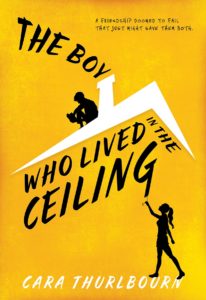 Cara Thurlbourn is a UK writer with a passion for all kinds of storytelling, particularly Young Adult books. Cara worked as an editor for nearly ten years but in 2016 she turned her hand to writing and has never looked back. Cara now spends her days in a small wooden ‘writing shed’ in her garden drinking too much tea and bringing the characters we’re going to love to life.
Cara Thurlbourn is a UK writer with a passion for all kinds of storytelling, particularly Young Adult books. Cara worked as an editor for nearly ten years but in 2016 she turned her hand to writing and has never looked back. Cara now spends her days in a small wooden ‘writing shed’ in her garden drinking too much tea and bringing the characters we’re going to love to life.
It was the stuff of nightmares. If they knew. If they found out…
Wise Wolf Books: Not only are you an author, but I saw that you also offer author services. When did you start writing and how did you decide you wanted to help others?
Cara Thurlbourn: I started writing in 2016. Before that, I’d dabbled in it but hadn’t written anything more than a few pages here and there. 2016 was the year I turned 30, so I gave myself a goal to write the first draft of my first novel before my 30th birthday. It was close, but I made the deadline!
I started helping others to publish by accident, really. I did an MA in publishing and had worked in the industry for a while, so when I started writing people around me began to ask for my help. After my son was born, I saw it as a good opportunity to carve out a career that would allow me to be flexible and to make my own writing a priority. I’m quite goal oriented, so everything has very much been part of working towards the goal of being a full-time author. But I also love coaching and helping people to get their books out into the world because it’s a space that can seem quite overwhelming if you’ve not been involved in it before.
WWB: You write primarily children’s and YA, but what is your favorite genre to read and what are you reading right now?
CT: I’m actually a bit of a butterfly when it comes to reading. I have quite eclectic tastes, so I flit between YA, crime, and contemporary fiction. Because I spend a lot of time writing, I now consume most of my books in audio format and at the moment I’m listening to a book called The Amazing Story Of The Man Who Cycled From India To Europe For Love. It’s a true story, and one of those books that just grabs you from the first sentence. I think if you were to look for a theme with what I read, I’m drawn to anything with a strong human story at its heart.
WWB: Where do you draw inspiration for your books from?
CT: I used to work at an academic publisher which produced materials on social issues for high school students. My job involved a lot of research, and I had a notebook where I kept my story ideas. Now, I make an effort to read the news every day – often looking for those small little stories that no one takes much notice of – and I keep a notebook handy in case I hear something on the radio that grabs my attention. Often, I’ll see people who intrigue me too and I’ll jot them down.
WWB: You’ve been a part of the publishing industry for quite some time now, what is your favorite part about the process of seeing a book come to life?
CT: I just love the whole thing. When my parents moved house recently, they discovered a list I wrote when I was eight years old where I said that when I grew up I wanted to either ‘draw cartoons for Disney’ or ‘make books’. Sadly, I can’t draw for toffee. But being a part of the publishing industry and now writing too has made my second dream come true. I just think it’s amazing that something can go from a tiny flicker of an idea to a novel-length story to something that other people read and engage with. AS an author, that’s definitely my favourite part – knowing that someone has read my words and that they’ve given them some joy or comfort.
WWB: Tell us a bit about what your writing space looks like – are you organized or a little more chaotic?
CT: Haha. It varies. Sometimes, I write in our shared study which can get a bit messy. But I now also have a writing shed in my garden. It’s literally a small wooden shed with windows, an electric heater, and a chair. I make an effort to keep it ‘stuff’ free so that I don’t have any excuse to distract myself or procrastinate and having a separate space away from the house helps my brain to understand ‘oh, okay, we’re writing now.’ It also prevents my husband or son from disturbing me every five minutes!
Let’s talk a little about the book – The Boy Who Lived in the Ceiling:
WWB: This obviously is not a horror story, but when you Google ‘man in attic’ so many horror stories of real-life events pop up. Have you read about any of these stories and did they inspire ‘Boy’ at all?
CT: Oh my goodness, I know! When people ask me to describe the book I always have to assure them it’s not creepy or weird. And I hope the way that it’s written gets that across to the reader.
‘Boy’ was actually an amalgamation of two pieces of research that I came across when working on a book about homelessness as part of my old job. I read a story about a Japanese woman who had lived in the top of someone’s wardrobe for four months before they noticed (!) and at the same time I saw a YouTube video of a man who dressed up in a suit and asked for money to demonstrate that people were more willing to help someone who looked respectable than someone who looked homeless. The two elements kind of percolated in my brain for a while and then combined into this idea about a homeless boy trying to turn his life around, and what would happen if he was found out.
WWB: Reading this book instantly took me back to my teenage years and the dramatic events that every teenager thinks is the end of the world. Although coming from a seemingly normal and happy family, Violet experienced a lot. Where do you think she drew her strength from?
CT: I think she draws it from her family. Although their lives are complicated and they have a lot going on, at their core they’re a close family unit and that’s probably why she’s able to cope with what she does in the way that she does.
Meeting Freddie also helps her. I think he comes along at a point where things could have gone either way for Violet; she could have started to go ‘off the rails’ because of everything that was happening in her life but helping him becomes her focus. In a weird way though, and this is what I’ve always liked about the story, although Freddie seems like the one who needs help, really they both need something that the other one can give. They are each other’s strength.
WWB: Do you believe that homelessness is something teenagers should be aware of, and helping with at such a young age?
CT: I absolutely think it’s something that young people should be aware of. Actually, I think we all should be a little more conscious of it. No matter what age we are, as Freddie experiences, it’s an uncomfortable thing to confront. And it’s easy to put the issue in a box and think of it as something that happens to other people. What I hope people recognize in Freddie’s story is that his situation came about because of a domino-effect of tragic and unfortunate circumstances. He’s no different from anyone else and, actually, Violet’s life could almost have gone the same way. If her dad had dealt with his redundancy differently or hadn’t been able to cope with the loss of his mother, her family could have splintered in a similar way.
WWB: What do you want the biggest takeaway from The Boy Who Lived in the Ceiling to be?
CT: Oh, gosh. That’s a hard question. It would be easy to say, ‘I hope it raises awareness of teen homelessness’ but I think that’s a little patronizing towards the reader. Of course, the book highlights that issue. But, honestly, I would like people to take what they need from the book. That probably sounds terribly cheesy, but my absolute favourite quote about reading and writing is from Alan Bennet’s The History Boys:
“The best moments in reading are when you come across something — a thought, a feeling, a way of looking at things — that you’d thought special, particular to you. And here it is, set down by someone else, a person you’ve never met, maybe even someone long dead.”
So, I just hope that if someone recognizes an element of Freddie or Violet’s story as a reflection of events or feelings from their own life, they can take comfort from knowing that they’re not alone. Whether it’s the grief Violet feels over her grandmother’s death, or Freddie’s guilt about his past, or even the bullying that Violet experiences, I think there are elements in the book that many of us will empathize with.
WWB: And of course, we cannot end this without asking about your dog! What is her name and what type of dog is she?
CT: Oh, thank you. She’s called Molly and she’s a mixture of Belgian Shepherd, Greyhound and Whippet. We call her Bat Dog because that’s the nickname they gave her at the rescue center we rehomed her from – due to the enormous ‘bat’ ears! She’s usually found either lounging on the couch or with me in the writing shed.
